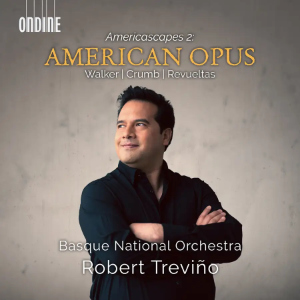
Americascapes 2
George Walker (1922-2018)
Address for Orchestra (1959)
George Crumb (1929-2022)
A Haunted Landscape (1984)
Silvestre Revueltas (1899-1940)
La Coronela, Ballet (1940)
Basque National Orchestra/Robert Treviño
rec. 2023, Miramón, Donostia-San Sebastián, Spain
Ondine ODE1445-2 [69]
Americascapes 2 not surprisingly follows on from the same players as Americascapes which appeared on the same label in 2021 when it was highly recommended by Néstor Castiglione (review). That disc included a fascinating selection of lesser-known works by American composers. This one is no less interesting, though it expands the geography and includes two Americans and a Mexican.
George Walker, the long-lived African American pianist and Pulitzer Prize winning composer, has been rediscovered in the years since his death. To my mind, it would be far better if composers were feted while alive – but better late than never, I suppose. The three movements which comprise Address for Orchestra were completed in 1959, near the end of his studies with Nadia Boulanger, but had to wait until 1971 for a first performance. It is hard to believe it was the composer’s first work for large ensemble, as the three movements sound confidently written in structure and brilliant in orchestration. Very much in the sound world of Copland, Harris, Diamond, etc., the eighteen-minute work is a marvellous discovery. A less discriminating composer may have called the three movements a symphony and I would not have complained. Inspired by Lincoln’s Gettysburg Address, it is a suitably dignified work. The first is sinuously dramatic and rigorously thought through. The orchestration is colourful though restrained; just the right amount of muted trumpets here and judicious use of percussion there. The following two movements, an introspective molto adagio leading into a brooding dramatico which builds to a tremendous climax, are finely shaped by Treviño and brilliantly captured by the engineers. The work had a previous outing in 2008 on Albany records, but this version has far more fire about it.
George Crumb, another long-lived composer, was one of the names of the sixties and seventies. His colourful works for many varied ensembles performed from his beautiful hand drawn scores, often with unusual layouts of the staves, seemed to be everywhere. Their often-theatrical demands on performers provided a welcome relief from the dry academic serialism of his colleagues. He was of course an academic himself, teaching for many years at the University of Pennsylvania. By the time of A Haunted Landscape commissioned by the New York Philharmonic in 1984, his profile was on the wane. It can be heard of as a sixteen-minute tone poem scored for large orchestra with triple woodwind and more than twenty percussion instruments.
The composer said of the work, “A Haunted Landscape is not programmatic in any sense. The title reflects my feelings that certain places on planet Earth are imbued with an aura of mystery…” It is a score full of Crumb’s trademark textures and colours. The first audible notes are a low cluster on the bottom end of the piano, but with the strings dampened with the right hand. Double basses are asked to tune their lowest C a note lower to Bb and over that rumble the harps enter, plucking with one hand and tapping the sound board with the other. Multi-divided strings enter in the manner of Ives with a slow-moving sweet sounding chorale and the stage is set for collisions and explosions conjuring up all manner of things that go bump in the night. Caribbean steel drums add unexpected touches of colour and very high clarinets scream in anguish. It all could sound like the score to some B movie horror film, but this is the thing, it doesn’t. Crumb was such a marvellous composer, so in command of all his outlandish materials, that even when it seems it is going to get out of hand, he pulls it all together again and draws us in. This is tough music to bring off, as it can hardly be familiar to any orchestra, but Mr Treviño, who worked with the composer, knows just how to pull everything together and take us on a tremendous journey. The Basque National Orchestra are superb in every way.
The final composer on the disc, Silvestre Revueltas, is the odd one out in not being American and not being long-lived. Born in Durango State, Mexico on New Year’s Eve 1899, he died at the age of just 40 from pneumonia exacerbated by alcoholism. The ballet presented here, which has something to do with skeletons and revolution, was left unfinished at the composer’s death. It was apparently pulled into a performing version by Candelario Huizar and later Jose Limantour, but as the composer’s sketches and manuscript have long since disappeared there is no conclusive proof this is what he intended. That said, both musicians knew the composer and his work, and the thirty-three-minute score sounds like Revueltas. There are mariachi bands, exciting rhythms and swaying waltzes. A Latin American Petrushka comes to mind. In the twelve-minute finale entitled The Last Judgement, every colour and emotion imaginable is squeezed into the score and it ends with a tremendous bang. I have never heard a piece of Revueltas I have not wanted to hear again and this is no exception. There was an earlier recording on Naxos (review) but this is in every way superior.
The Basque National Orchestra has been around only since 1982, but under their music director Robert Treviño it is clearly a musical force to be reckoned with. Ondine have done the musical world a great service by signing them up. They are certainly musicians to look out for.
Paul RW Jackson
Buying this recording via a link below generates revenue for MWI, which helps the site remain free




















